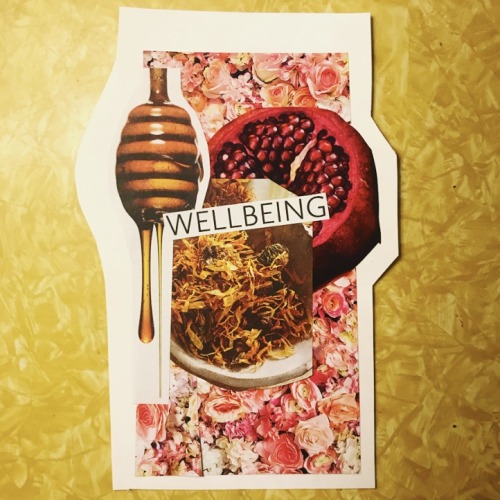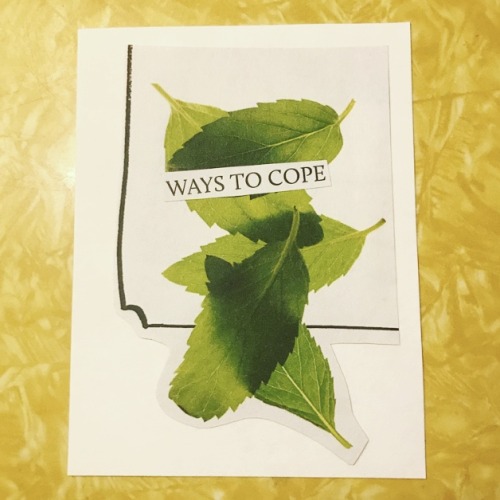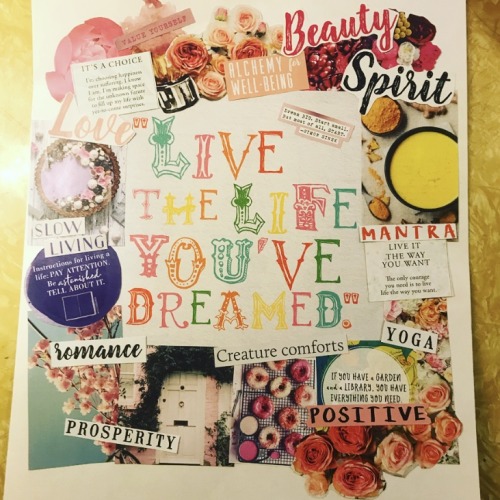School has started. I’m working a new job. I’m dissertating.
I’m feeling very motivated to start building new habits and boosting my mood, and I’ll be researching and practicing tools this month that will help me to achieve September’s blog theme: Live the Life You Want to Live.
Last week’s post on the Must-Do Method detailed the ways Must-Do lists are helping me to kick ass at work and establish a new perspective on productivity. This week’s post examines another, more widely known tool in the self development world: vision boards.
Vision boards have been suggested to me by numerous healers and coaches, with recommendations peppered across self development podcasts, books, and blogs. I wondered if vision boards were worth all of the attention they receive, so I spent last week researching the theories behind them and giving them a spin so I could pull out the most important takeaways for you use vision boards to visualize, plan, and manifest the lives you want to live.
What is a Vision Board?
A vision board is a compilation of images, words, or other objects that symbolize what you would like to manifest in your life. Vision boards are often linked to the Law of Attraction, a very old theory that was made popular by Rhonda Byrne’s The Secret.
According to Elizabeth Scott in “Understanding and Using the Law of Attraction in Your Life,” “the Law of Attraction works like this: you create your own reality. What you focus on, what you emote about, is what you draw into your life. What you believe will happen in your life is what does happen.” While many people argue in its favor, others have critiqued the Law of Attraction’s “like attracts like” message for its lack of action steps for achieving the things we desire.
Building on the Law of Attraction
If you’ve read my blog before, you know that I love practical steps and positive thinking. I like that the Law of Attraction asks us to name what we would like to manifest and asks us to maintain hopeful mindsets. Having done those two things, I think we should then utilize tools like vision boards and their resulting visualization practice to motivate ourselves to manifest change.
Vision Boards & Visualization Practice
Elizabeth Rider elaborates on how visualization enables manifestation in her Huffington Post article, “The Reason Vision Boards Work and How to Make One”:
“Creating a sacred space that displays what you want actually does bring it to life. What we focus on expands. When you create a vision board and place it in a space where you see it often, you essentially end up doing short visualization exercises throughout the day.”
Rider argues that visualization exercises have real affects on our lives, citing studies of athletes who utilized visualization practices to improve their actual performances.
Changing Your Mindset
Although some people have critiqued vision boards for their focus on imagination rather than establishing clear plans to help us follow through, they do encourage us to change our mindset, which is a big part of establishing new experiences in our lives. Carolyn Mehlomakulu, an art therapist and psychotherapist and the author of the blog “Creativity in Therapy,” writes about her positive experience with vision boards in her post “Realizing the Future: Creating a Vision Board”: “Through the process of choosing my images, I was able to clarify my goals and hopes, think about what I consider to be truly important in my life, open my mind to the possibility of having the life and business that I want, and inspire myself to keep moving forward.” These practical steps are wonderful examples of how visualization can encourage us to enact change. Additionally, I was moved by Mehlomakulu’s statement that
“…we may not believe that we are worthy of the ideal future, thus not even trying for it or unconsciously sabotaging ourselves. Creating a vision board can be a helpful exercise in believing that you deserve the things that you want and opening yourself to the possibilities.” (emphasis original)

Make A Vision Board that Works
Establish Your Vision
While you could just skim through a magazine or Pinterest with an eye for images and words that feel in line with your dreams, I encourage you to start out with some journaling so you have a stronger grasp on your goals.
First, establish what part of your life you’d like your board to focus on. Career? Health? Home? Family? Or just a general “Where I’d Like To Be In Ten Years?” I made a big one on “The Life I Want To Lead.” It’s very important that you be honest and authentic—don’t simply list something because you feel like you should have that goal. For example: my Sweetie and I do not want to have kids, so there’s zero reason for me to put things that symbolize raising children on a vision board, even though other 30-somethings might do so.
Once you’ve established your goal, your next step is to brainstorm how you’ll get to that goal. What would you see, feel, taste, smell, hear? What words or emotions do you associate with it? What colors, seasons, moods, etc.? Get creative, and come up with a full list that gives you a sense of what your life will be like when you achieve your goals.
This first journaling step is important because it will help you to recalibrate your thinking about what you deserve and what you can achieve. For those of us who come from places of neglect or abuse, it can be difficult to feel like we “deserve” nice things—but establishing a vision of them in our future can help remind us that we do deserve to build safe, fulfilling, abundant lives.
Create Your Board
The traditional way to create a vision board is to make a collage of images, quotes, words, objects, etc. that all symbolize your goals and what you’d like to manifest. However, in this digital age you could easily use Pinterest or Canva or other programs to create a digital vision board. You could even make a vision altar on a shelf. Because vision boards are personal creations, there’s no right or wrong way to make them. That being said, I do agree with Elizabeth Rider’s suggestion that “your vision board should focus on how you want to feel, not just on things that you want.”
I went the traditional route and cut out images from a number of wellness, mindfulness, and food magazines, including Breathe, Mantra Wellness, Mother Earth Living, and Thrive. Some of these are pricey, but it’s a huge treat for me to read them before bed and use them for vision boards, so I don’t mind splurging a bit.
Cut out images or words and arrange them on a piece of paper or poster board. Once you feel good about how they all look together, glue or tape them into a collage. Your board may be large and encompass multiple aspects of your goals, or it might be a micro-vision board with just one word, like these ones that I made:



When you’re creating, try not to be too much of a perfectionist. I actually had to take a couple of breaks when creating my big vision board because I was feeling nervous about “messing it up.” When I came back to it with a “go with your gut” mentality I did a much better job choosing things for the board and arranging them.
Make Your Board Work For You
Put your board somewhere you will see it regularly. Every time you look at it, remind yourself that you are on a path to manifest that part of your life. For example, putting your Career vision board on your desk might encourage you to skip that Facebook hole and finish something from your Must-Do list instead. Putting a Self-Love board on your bathroom mirror might encourage you to say positive things to yourself when you get out of the shower.
I also recommend that you do some journaling after you’ve created your board. Looking at it, isolate some images or words and answer the questions “what does this image/word symbolize?” and “what practical steps can I take on the short and long terms to achieve it? What can I do today to achieve it?”
For example, I put a fancy food on my “Life I Want to Lead” board because this symbolizes building a life where I have time and energy left over to cook and because I want to keep healing from my trauma related to food scarcity. Similar to “slow living,” these delicious treats symbolize a life of agency and comfort that I aim to manifest through my career, healing, and self care practices.
Kate’s “Life I Want to Lead” Vision Board

*Please note that the original version of this blog post was published here.
Newsletter
Sign up below to access my free newsletter, Tending with Dr. Kate Henry.

